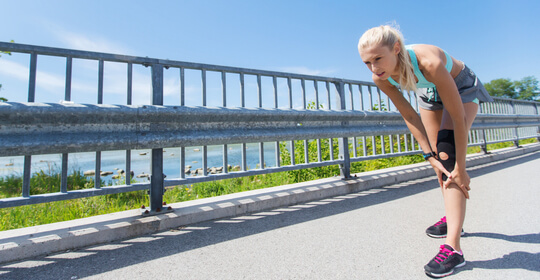The Runner’s Guide to Chondromalacia

Knee pain is a common complaint for athletes who participate in repetitive-impact sports like running. It is easy to understand when you consider the remarkable forces the knee absorbs through walking, let alone the addition of increased loads present with running.
Pain in the front of the knee for this athletic population can be debilitating and limit the amount or frequency of running. Often called “runner’s knee”, or chondromalacia patella, this pain in the front of the knee is caused by softening and breaking down of the cartilage under the kneecap.
What is Chondromalacia?
Chondromalacia patella is widely characterized by pain on the front and sometimes the side of the knee. Often, a tight iliotibial band—the tight layer of tissue that runs along the side of the thigh—can be implicated in development of runner’s knee because it pulls the kneecap out of alignment. When the condition presents as pain on the front of the knee, on or under the kneecap, it is also known as patellofemoral pain syndrome (PFPS).
In a normal, healthy knee, the kneecap glides smoothly up and down the femoral groove (or trochlear groove, which is located on top of the femur. With runner’s knee, the kneecap doesn’t glide smoothly in the femoral groove, causing increased pressure and pain.
Symptoms of Chondromalacia
Pain is the main symptom of runner’s knee. It is a chronic condition caused by overuse. Unlike a sudden, traumatic injury, the pain of this condition comes on slowly. The knee pain is usually present while running or during other activity, such as:
- Running, specifically downhill
- Kneeling
- Squatting
- Walking up or down stairs
- Sitting for long periods
Other symptoms of runner’s knee may include:
- Swelling in the knee
- Cracking or popping sound in the knee joint
- Kneecap being tender to the touch
Causes of Chondromalacia
The most common cause of runner’s knee is weakness and tightness of the leg muscles and core. Running, by nature, develops some muscles while others get little or no work, leading to weakness. This creates a muscle imbalance, often in the hip area.
Due to weak or tight muscles, a malalignment occurs, affecting the body’s ability to control the appropriate tracking of the kneecap in the femoral groove during running. This mal-tracking often occurs as your leg fatigues with continued running and can lead to damage to the cartilage on the underside of the patella. In addition, lack of flexibility or muscle strength in the large muscles of the legs (glutes, hamstrings, quadriceps) as well as the Achilles tendon all can contribute to runner’s knee.
Other causes or risk factors of chondromalacia include:
- Excessive training and overuse
- Increased training level
- Flat feet
- Poor running mechanics
- Foot over-pronation (feet that roll inward when walking or running, causing the kneecap to be pulled outward)
- Injury, trauma to the kneecap (e.g. dislocation, fracture)
- Obesity
- Improper or worn-out running shoes
- Prior knee or hip surgery
Treatment for Chondromalacia
Chondromalacia patella is usually treated with conservative measures. These may include:
- R.I.C.E. (Rest, Ice, Compression, Elevation)
- Anti-inflammatory medications
- Stretching and strengthening of surrounding muscles and other structures of the knee, especially the glute and quadriceps muscles of the leg.
- Special shoe inserts (orthotics) if indicated
Although surgery is not usually necessary, a severe case of chondromalacia may benefit from surgical options, which are minimally invasive.
Prevention of Chondromalacia
- Wear supportive shoes, especially if your feet turn inwards
- Warm up and stretch before running, with a focus on the legs, before running.
- Rest or cross train between running sessions, especially if they are rigorous
- Supplement running with runner’s knee exercises: a targeted flexibility and strengthening program
- Consult an expert for an evaluation of your running form or running-related pain or other problems. Consider going to a physical therapist or professional trainer for a targeted stretching/strengthening program.
If the condition lasts for longer than three weeks, interferes with walking or running, or gets worse, professional evaluation is indicated. Although rare, over time it may result in permanent knee cartilage damage. Seeing an orthopaedic specialist at UOA can provide a confirmed diagnosis, including ruling out other causes or injuries.

